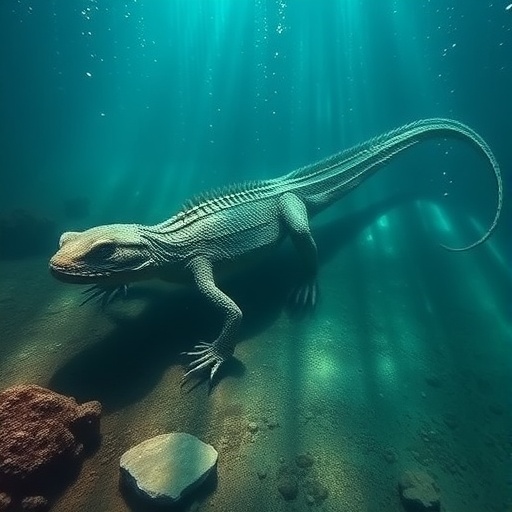Deep within the Arctic region, on the frigid island of Spitsbergen in the Svalbard archipelago, an extraordinary paleontological treasure has emerged, shedding profound new light on the recovery of marine ecosystems following Earth’s most devastating mass extinction. A remarkable bonebed, densely packed with fossils from more than 249 million years ago, offers an unprecedented window into the early Triassic oceanic tetrapod communities, uncovering the rapid reestablishment and complexity of life in marine environments mere millions of years after the catastrophic end-Permian extinction.
The end-Permian mass extinction, often dubbed the ‘Great Dying,’ represents one of the most severe biological crises in Earth’s history. Around 252 million years ago, this event eradicated more than 90% of marine species worldwide, fundamentally reshaping global ecosystems. The extinction’s driving forces comprised hyper-greenhouse climate conditions, widespread ocean deoxygenation, and acidification, largely triggered by extensive volcanic activity and the tectonic rifting of the supercontinent Pangaea. For decades, paleontologists have debated how rapidly marine life rebounded after such devastation.
Traditional evolutionary narratives have long favored a gradual, protracted recovery timeline spanning roughly eight million years. According to these views, amphibians and reptiles progressively adapted to open ocean ecosystems through a series of incremental evolutionary steps. Yet this prevailing hypothesis has been fundamentally challenged by the discovery of the dense fossil bonebed on Spitsbergen, which signifies an abrupt, rapid complexification of marine communities far earlier than previously assumed.
Excavated meticulously since its initial unearthing in 2015, the Spitsbergen fossil site has yielded over 800 kilograms of diverse remains. Researchers have focused on an area approximately 36 square meters, extracting fossils within precisely measured one-square-meter grids to maintain rigorous stratigraphic and ecological context. These fossils range from minuscule fish scales and shark teeth to sizable bones of marine reptiles and fossilized coprolites, facilitating an extraordinarily comprehensive reconstruction of the ecosystem.
Stratigraphic analysis situates this bonebed at about 249 million years ago, only three million years after the Permian-Triassic boundary. This brief interval indicates a remarkably swift ecological rebound, contradicting the long-held assumption of gradual marine recovery following the mass extinction. Instead, the data reveal that complex trophic interactions involving multiple predatory taxa were already established, suggesting that marine food webs reorganized and diversified at unprecedented rates.
Central to this ecosystem were a variety of aquatic reptiles, particularly members of the ichthyopterygian clade — colloquially known as ‘fish-lizards.’ These creatures demonstrated a remarkable diversity in size and ecological strategies, ranging from small squid-hunting species under one meter in length, such as Grippia longirostris, to colossal apex predators like Cymbospondylus surpassing five meters. These ichthyosaurs coexisted with the marine amphibian Aphaneramma, which actively preyed on bony fishes such as Bobastrania, illustrating a complex and fully marine trophic network.
The Spitsbergen bonebed provides the earliest concrete fossil evidence of offshore-specialized tetrapods, highlighting an evolutionary transition of vertebrates from terrestrial or nearshore habitats into fully pelagic niches. This ecological expansion redefines timelines for marine adaptation, implying the origins of sea-going reptiles and amphibians predated the end-Permian extinction event itself. The fossil assemblage thus signals an ‘ecosystem reset,’ wherein vacant feeding niches created by mass extinction promoted rapid diversification and complexification.
Further supporting these interpretations is a computer-based global comparative analysis conducted by the study’s authors. This quantitative approach underscores the extraordinary species richness of the Spitsbergen fossil assemblage in the context of early Mesozoic marine vertebrate records worldwide. It confirms the assemblage as one of the most diverse and ecologically intricate early Triassic marine vertebrate communities ever documented.
The implications of these findings extend far beyond the Arctic fossil site. They demand a reexamination of marine evolutionary trajectories in the wake of the Permian extinction and highlight the resilience and adaptability of vertebrate life in post-crisis ecosystems. These insights resonate strongly with broader studies of evolutionary recovery dynamics, ecosystem stability, and biological innovation following severe environmental perturbations.
The research, conducted by an international team of paleontologists from the Natural History Museum at the University of Oslo and the Swedish Museum of Natural History, combines field excavation, detailed stratigraphic study, and advanced analytical techniques. Their collaborative efforts have culminated in this groundbreaking study, which was published as a cover feature in the journal Science, one of the premier platforms for scientific discovery.
Scientists involved emphasize that the fossils from Spitsbergen are not just of academic interest; they represent a vivid chronicle of life’s resilience and the rapid ecological transformations that shape our planet’s biological heritage. Ancient marine reptiles from this site are now exhibited for public viewing at the University of Oslo Natural History Museum and the Swedish Museum of Natural History, offering a tangible connection to this critical epoch in Earth’s history.
This discovery underscores the importance of Arctic fossil sites in understanding global patterns of evolutionary history. The precise stratigraphic context of the Spitsbergen bonebed, combined with the richness and diversity of fossils, offers unparalleled insight into the early Mesozoic marine ecosystems. As paleontologists continue to explore these sites, future research is likely to yield even more compelling stories of life’s evolutionary tenacity and the rapid reassembly of complex ecosystems following mass extinction events.
In sum, the earliest known oceanic tetrapod ecosystem revealed from the Spitsbergen bonebed challenges longstanding paradigms about the pace and nature of marine recovery after Earth’s greatest extinction. Through detailed fossil analysis and global comparative methods, this study demonstrates that complex marine communities with diverse reptilian and amphibian predators existed far earlier than previously recognized, highlighting a rapid and dynamic renewal of oceanic life during the Triassic.
Subject of Research: Animals
Article Title: Earliest oceanic tetrapod ecosystem reveals rapid complexification of Triassic marine communities
News Publication Date: 13-Nov-2025
Web References: 10.1126/science.adx7390
References:
Roberts, A.J., Rucinski, M., Kear, B.P., Hammer, Ø., Engelschiøn, V.S., Scharling, T.H., Larsen, R.B., and Hurum, J.H. (2025). Earliest oceanic tetrapod ecosystem reveals rapid complexification of Triassic marine communities. Science.
Image Credits: Robert Back
Keywords: Early Triassic, end-Permian mass extinction, ichthyopterygian, marine reptiles, Svalbard fossils, ecosystem recovery, tetrapod evolution, paleoecology, marine biodiversity, fossil bonebed, rapid complexification, Arctic paleontology




